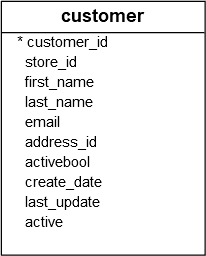PostgreSQL REVERSE() Function
Summary: in this tutorial, you will learn how to use the PostgreSQL REVERSE() function to reverse the characters within a string.
Introduction to PostgreSQL REVERSE() function
The REVERSE() function accepts a string and returns a new string with the order of all characters reversed.
Here’s the syntax of the REVERSE() function:
REVERSE(text)In this syntax:
text: The input string that you want to reverse.
The REVERSE() function returns a string with the order of all the characters reversed.
The REVERSE() function returns NULL if the text is NULL.
MySQL REVERSE() function examples
Let’s explore some examples of using the REVERSE() function.
1) Basic PostgreSQL REVERSE() function example
The following example uses the REVERSE() function to reverse the string "SQL":
SELECT REVERSE('SQL');Output:
reverse
---------
LQS
(1 row)2) Using the PostgreSQL REVERSE() function with table data
We’ll use the customer table from the sample database:
 The following example uses the
The following example uses the REVERSE() function to reverse the first names of customers:
SELECT
first_name,
REVERSE(first_name)
FROM
customer
ORDER BY
first_name;Output:
first_name | reverse
-------------+-------------
Aaron | noraA
Adam | madA
Adrian | nairdA
Agnes | sengA3) Using REVERSE() function to detect palindromes
A palindrome is a string that reads the same forward and backward such as "radar".
You can use the REVERSE() function to reverse a string and then compare the reversed string with the original string to determine if it is a palindrome. For example:
First, create a new table called words to store the words:
CREATE TABLE words(
id SERIAL PRIMARY KEY,
word VARCHAR(255) NOT NULL
);Second, insert some rows into the words table:
INSERT INTO words(word)
VALUES('radar'), ('level'),('civic'),('man'),('12321'),('madam')
RETURNING *;Output:
id | word
----+-------
1 | radar
2 | level
3 | civic
4 | man
5 | 12321
6 | madam
(6 rows)Third, determine if a value in the word column is a palindrome using the REVERSE() function:
SELECT
word,
REVERSE(word),
(
word = REVERSE(word)
) palindrome
FROM
words;Output:
word | reverse | palindrome
-------+---------+------------
radar | radar | t
level | level | t
civic | civic | t
man | nam | f
12321 | 12321 | t
madam | madam | t
(6 rows)Summary
- Use the PostgreSQL
REVERSE()function to reverse the order of characters within a string.